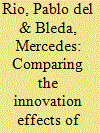| Srl | Item |
| 1 |
ID:
128370


|
|
|
|
|
| Publication |
2014.
|
| Summary/Abstract |
International shipping transports around 90% of global commerce and is of major importance for the global economy. Whilst it is the most efficient and environmentally friendly mode of transport, CO2 emissions from shipping activities still account for an estimated 3% of global emissions. One means of significantly reducing fuel consumption and thereby GHG emissions from shipping are wind propulsion technologies (i.e. towing kites, Flettner rotors and sails) - yet current market uptake is very low. Therefore, the aim of this article is to identify the barriers and drivers for the uptake of wind propulsion technologies. To this end, the theoretical approach of technological innovation systems is adopted. This approach combines structural system components with so-called system functions which represent the dynamics underlying structural changes in the system. The fulfillment of these functions is considered important for the development and diffusion of innovations. Based on newspaper and academic articles, online expert interviews and semi-structured interviews, the level of function fulfillment is evaluated, followed by the identification of structural drivers and barriers influencing function fulfillment. Third, the possibilities to influence these drivers and barriers are discussed.
|
|
|
|
|
|
|
|
|
|
|
|
|
|
|
|
| 2 |
ID:
116713


|
|
|
|
|
| Publication |
2012.
|
| Summary/Abstract |
The aim of this paper is to provide a comparative assessment of the innovation effects of instruments which support the diffusion of renewable electricity technologies with a functions-oriented technological innovation system perspective. The paper provides a link between two major streams of the literature: the functions of innovation systems and the literature on renewable electricity support schemes. We show that, when a functional perspective is adopted, feed-in tariffs are likely to be superior to other policy instruments (quotas with tradable green certificates and tendering), although they still need to be complemented with other instruments, most importantly, direct R&D support. Furthermore, those innovation effects are affected by the specific design elements of the instruments chosen.
|
|
|
|
|
|
|
|
|
|
|
|
|
|
|
|
| 3 |
ID:
177452


|
|
|
|
|
| Summary/Abstract |
Legitimacy is a key function within Technological Innovation Systems (TIS), influencing the development and diffusion of novel technologies such as onshore wind energy. By combining insights from TIS and from organization studies, we provide theoretical and empirical underpinnings to ‘legitimacy’, a concept often defined superficially and mapped at an aggregate, national level. We add a spatial perspective by comparing dimensions of legitimacy between two heterogenous regions in Germany. They have similar diffusion trajectories of wind energy but differ in structural features (socio-economic factors and TIS elements). To capture place-specific institutions and dynamics influencing regional legitimacy, we focus on decision makers and their perception of the TIS. Even though politicians and civil servants are crucial for wind development in their constituent regions and are thus important contextual actors to the TIS, their perspective has been mostly neglected. Applying a comprehensive, mixed methods approach, we conducted an online survey among these decision makers and complemented the insights with qualitative expert interviews. Our analysis shows that pragmatic and moral dimensions of legitimacy are particularly susceptible to place-specific influences. These spatially sensitive insights have been missing from the debate on legitimacy so far and might inform policy directed at advancing technological legitimacy in certain regions.
|
|
|
|
|
|
|
|
|
|
|
|
|
|
|
|